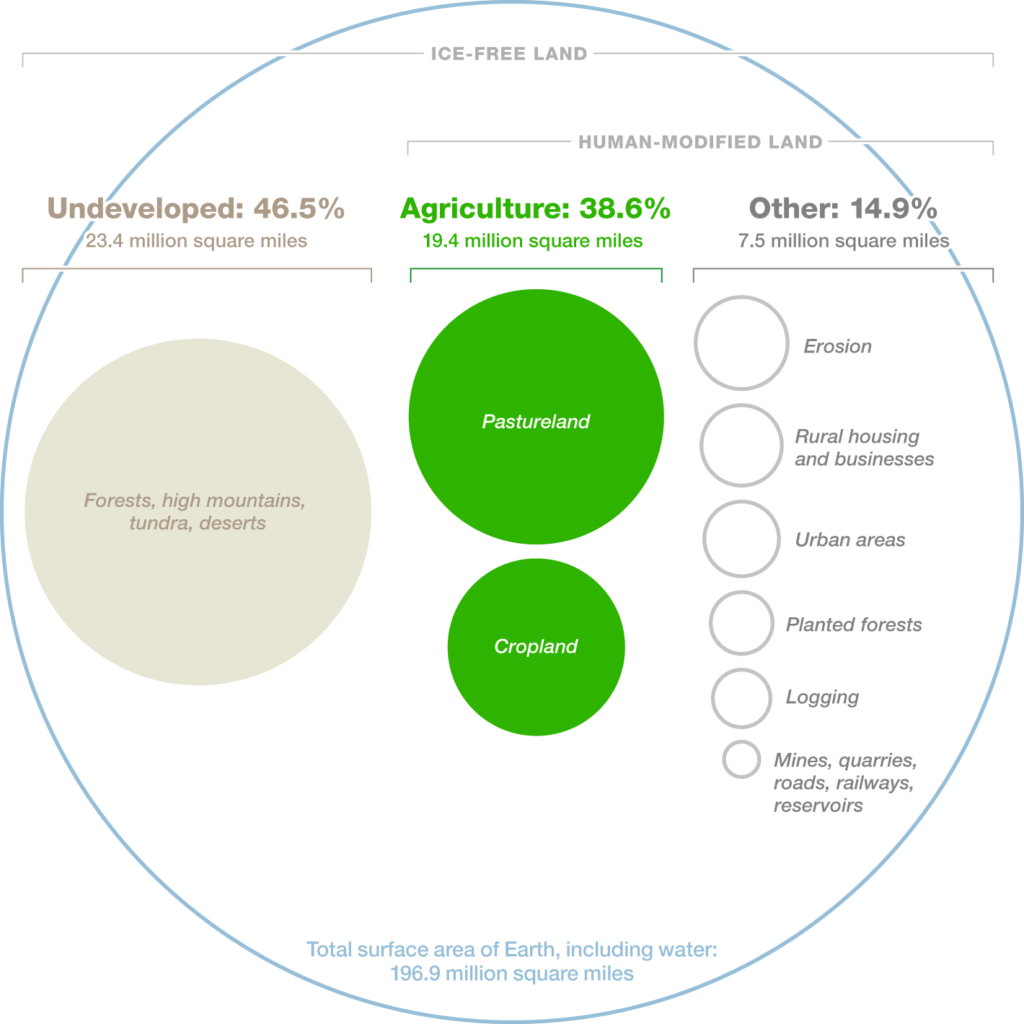How does our future look?
Let’s consult our crystal ball and peer into the future of food. While we can’t predict any certainties in the wild world of agriculture, we can try to forecast and strategize how best to grow our food as demand changes. Our undertaking will be unprecedented: our farmers must keep up with the insatiable appetite of an exploding global population. And by exploding, we mean there is a very real possibility that 10 billion people will live on Earth by 2055.

Production must be swift and efficient as we crank up the global demand for food and agricultural products.
In this blog, we will look at how farming and food production is changing and what are some of the key trends ahead. We’ll try not to get too grim about some of the alarming aspects of our global trajectory (i.e. overpopulation, climate change, and rapid urbanization) but rather, we’ll examine hopeful solutions for the future and how Ontario fits in the equation.
Farming Past
There’s a reason we take history classes in school; hindsight is always 20/20, and we can learn from previous blunders to forge a brighter future. In agriculture, our fore-farmers learned by trial and error and through sharing their knowledge with one another. From its crude beginnings, spawning from around hunting and trapping outposts, agriculture in Southwestern Ontario has evolved spectacularly from the early wooded wilderness of the 18th century. The various origins of the United Empire Loyalists (Highland Scottish, German, Dutch, Irish Palatine, French Huguenot, English) brought with them the knowledge and experience of clearing land and forging homesteads in heavily wooded New York State.

We’ve benefited from the laborious efforts of our ancestors. They paved the way for the innovations and crop diversity that make Southwestern Ontario a giant in food production today.
Early settlement agriculture expanded, became more organized, diversified and scientific, and was revolutionized by farming machinery and technology. There’s plenty more fascinating details about the origins of Southwestern Ontario agriculture and how it shaped the farmland and organizations we know today. The traditional methods we’re familiar with have adequately fed the human demand for the most part. The global population explosion has really only happened in the last century. So now we’re confronted with the reality of the future: We need to produce more food in the next 30 years than we have in the last 10,000 years. Today, our methods are scientific and tested rigorously, we have the aid of machines and technology, and we can connect with people, resources, ideas via the internet.

Many modern farmers turn to social media as sources for insight, strategies and the latest farmland buzz to stay in the know.
When it comes to increasing yields, the agricultural industry has always been driven by investigative minds and our farmers’ willingness to adopt new game-changing technologies —which brings us to our next phase of farming…
Farming Present
Ontario is on the cusp of a revolution in agricultural technology, research, and opportunities in the global market. According to Evan Fraser, head of the University of Guelph’s Food Institute, Canada is poised to become a leader in the agri-food sector. It’s a pivotal moment for both Canada and Ontario. Fraser speculates that, “the same technology that’s propelled growth in other industries, such as robotics and data analytics, hold the promise of producing more food on less land. “
In areas of Canada with longstanding productive farmland, such as Southwestern Ontario, the groundwork has already been laid. The farmland is well-supported by infrastructure, skilled farm families, rich soil, an abundance of heat and perhaps most importantly, ample and consistent rainfall. Global warming is actually improving the productivity of farmland in Ontario. Ontario is poised for the next agricultural revolution. Industry leaders are fine-tuning their approach to high-tech farming and therefore it makes good sense that new strategies are being applied in farmland regions that can benefit the most from the new technologies
Stan Blade, dean of the University of Alberta’s faculty of agricultural, life and environmental sciences says, “The farmers who succeed are the ones who are going to incorporate new technologies,”
Some of these technologies include
- Carbon sequestration – increasing organic matter in soil
- Water management – biotechnology, drip irrigation
- Adapting to climate change – biotechnology
- Precision AG (Sensors, Robots and Data)
- Planter Prescriptions
- Drones, Satellite Imagery, GIS and GPS
- Farm connectivity
- Data collection, management and integration through the food chain

A modern John Deere tractor using GPS guidance technology, seed monitoring systems and variable rate fertilizer application.
Farming Future
What needs to happen before we can feed 10 billion people? According to National Geographic, we need to grow roughly DOUBLE the amount of global crop output by 2050 and we need to do so on roughly the same amount of land that we now have available to us.

Looking at the big picture inspires streamlining our collective efforts to use land more efficiently for a global increase in crop yields.
But there is hope, it can be done. The article proposes a 5-step plan developed by scientists from all over the world. The major proposals are; reducing agriculture’s footprint, growing more on existing farmland, using resources more efficiently, shifting diets, and reducing waste. It will require a lot of collaborative efforts and critical thinking, but Southwestern Ontario is already leading by example.
Southwestern Ontario: Are we up to the task?
Our industry leaders and our growers are not faint-hearted people. The personal commitment and dedication of our farmers is unshakable. Our future farmers and brightest agricultural scientists can set the stage. We will continue to lead developments in sustainable food production and careful use of land and resources.
